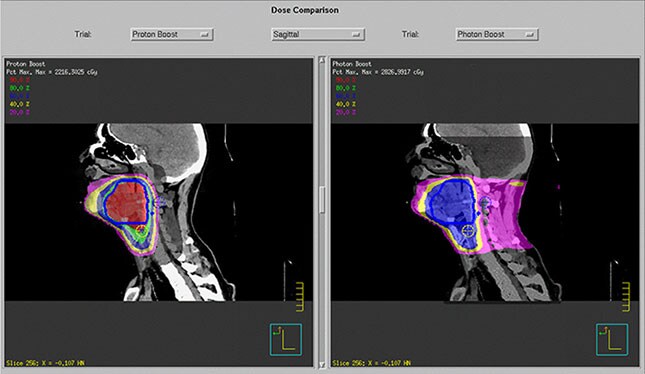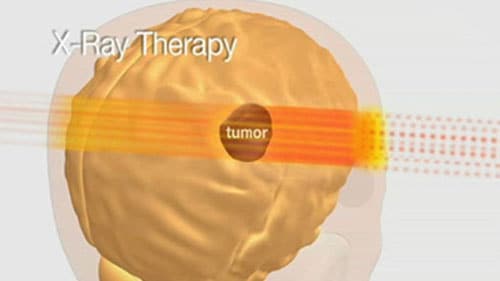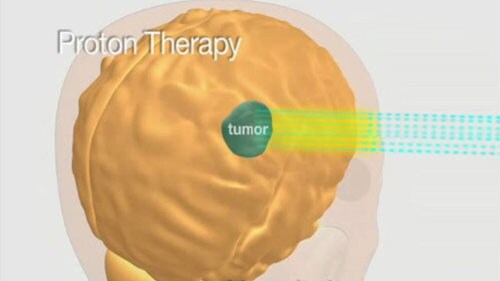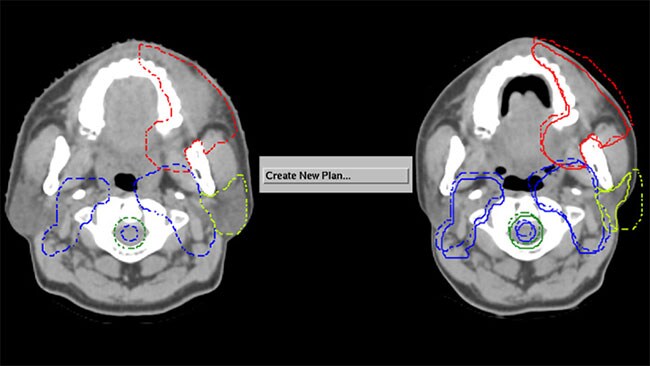Proton therapy is a promising new treatment in radiation oncology, using a beam of protons to irradiate cancer or other diseased tissue. The primary advantage of proton therapy compared with other types of external beam therapy is the ability to more precisely localize the radiation dose within the patient’s body, thereby sparing healthy tissue and reducing the risk of secondary tumors. Philips Pinnacle³ Proton Planning has been designed to meet the growing demand for proton therapy by integrating it within the conventional external beam treatment planning process. This material is not for distribution/use in the USA and Canada
Benefits: less toxicity and higher cure rates
In most cancers requiring radiation therapy, proton therapy can provide better radiation dose distributions with respect to cancer and normal tissue than techniques employing X-rays.1 This better radiation distribution can be very important for patient outcome in certain clinical situations, and this drives the demand for proton therapy treatment. Based on the clinical and technical literature, proton therapy benefits include: Tumor types where proton therapy offers advantages are lesions of the brain, spinal cord, skull base, eye, head and neck, and also chordomas, early lung cancers and pediatric tumors. Other uses are being investigated.

Enhanced tissue sparing with proton treatments
Sparing healthy tissue by leveraging the unique characteristics of protons
The photons in an X-ray beam start losing energy the moment they enter the body. To ensure a sufficient radiation dose at the tumor site, photon treatments expose healthy tissue in front of the tumor to a relatively high dose of radiation. To minimize tissue damage, photon treatments are applied through several beam angles. If the tumor is embedded in sensitive structures, however, this solution doesn’t always suffice. Protons deposit most of the energy at the end of the beam and don’t travel through the body like photons. This unique characteristic of proton energy deposition differentiates proton treatment from other forms of external beam radiation therapy and allow it to more precisely localize the radiation dose to the target volume while sparing critical structures.


Proton therapy can be used to precisely target tumors and reduce the radiation dose to healthy tissues compared with X-rays. This is because, unlike photons, protons do not gradually lose energy as they travel through the body, but deposit most of their energy at the end of their path.
Philips Pinnacle³ Proton Planning expands treatment options
Philips supports the growing availability and demand for proton treatment by offering a turnkey module for proton planning on our trusted Pinnacle³ treatment planning platform. It enables proton therapy delivery for multiple devices using the double scattering and uniform scanning techniques. The module includes comprehensive evaluation tools to monitor the dose to the target and critical structures from different plans including photons, protons, and a composite plan.
“This capability has allowed us to confidently choose the best treatment modality for each patient."
Eric E. Klein
PhD Professor of Radiation Oncology Washington University, St. Louis MO

Fast assessment and automated re-planning of proton plans with Pinnacle³ Dynamic Planning.
“The interface still has a familiar feel as the photon-only program. Easy to adjust to.”
Randy Henderson
MD University of Florida Proton Therapy Institute, Gainsville, FL
Reaching more patients
There are 48 centers treating patients with protons today in the world, and plans for 52 new proton centers to open within the next 5 years. Many countries are investing in this technology as the evidence of its efficacy grows in the community and decreased cost of the delivery machine is making it even more attractive to entrepreneurs. Philips, as part of its overall oncology strategy, has recently announced a collaboration agreement with IBA, a leading provider in proton therapy delivery devices, to pursue research and exchange technologies to provide access to proton therapy solutions and enhance oncology care centers across the globe and reach more patients.
For more information
Read more about the collaboration between Philips and IBA in a previous issue of HotSpot. Find out more about proton therapy trends in this white paper: White paper from IBA: Technology Trends in Proton Therapy.
Written by:
Share this article
¹⋅ The Promise of Proton Therapy is Two‐fold—Less toxicity and higher cure rates than achievable with X‐ray therapy, Nancy Price Mendenhall, MD


